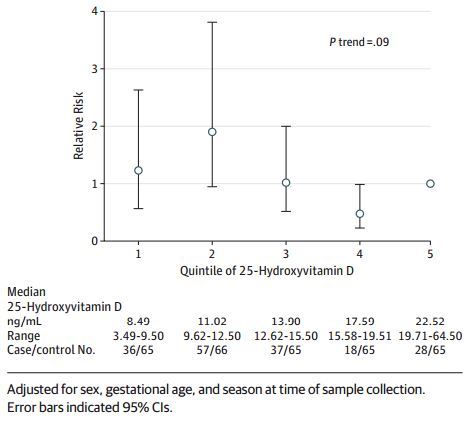Multiple Sclerosis 2X more likely if vitamin D deficient as a fetus decades earlier
Vitamin D Status During Pregnancy and Risk of Multiple Sclerosis in Offspring of Women in the Finnish Maternity Cohort
JAMA Neurol. 2016;73(5):515-519. doi:10.1001/jamaneurol.2015.4800.
Kassandra L. Munger, ScD1; Julia Åivo, MD2; Kira Hongell, MD2; Merja Soilu-Hänninen, MD2; Heljä-Marja Surcel, PhD3; Alberto Ascherio, MD, DrPH1,4
1Department of Nutrition, Harvard T. H. Chan School of Public Health, Boston, Massachusetts
2Division of Clinical Neurosciences, Turku University Hospital and University of Turku, Finland
3National Institute for Health and Welfare, Oulu, Finland
4Department of Epidemiology, Harvard T. H. Chan School of Public Health, Boston, Massachusetts

📄 Download the PDF from VitaminDWiki
Importance Vitamin D has been associated with a decreased risk of multiple sclerosis (MS) in adulthood; however, some, but not all, previous studies have suggested that in utero vitamin D exposure may be a risk factor for MS later in life.
Objective To examine whether serum 25-hydroxyvitamin D (25[OH]D) levels in early pregnancy are associated with risk of MS in offspring.
Design, Setting, and Participants Prospective, nested case-control study in the Finnish Maternity Cohort conducted in May 2011. We identified 193 individuals with a diagnosis of MS before December 31, 2009, whose mothers are in the Finnish Maternity Cohort and had an available serum sample from the pregnancy with the affected child. We matched 176 cases with 326 controls on region of birth in Finland, date of maternal serum sample collection, date of mother’s birth, and date of child’s birth.
Main Outcomes and Measures Maternal serum 25(OH)D levels were measured using a chemiluminescence assay. The risk of MS among offspring and association with maternal 25(OH)D levels were the main outcomes. Conditional logistic regression was used and further adjusted for sex of the child, gestational age at the time of sample collection, and season of sample collection to estimate the relative risks and 95% CIs.
Results Of the 193 cases in the study, 163 were female. Of the 331 controls in the study, 218 were female. Seventy percent of serum samples were collected during the first trimester of pregnancy. The mean (SD) maternal vitamin D levels were in the insufficient vitamin D range, but higher in maternal control than case samples (15.02 [6.41] ng/mL vs 13.86 [5.49] ng/mL [to convert to nanomoles per liter, multiply by 2.496]). Maternal vitamin D deficiency (25[OH]D levels <12.02 ng/mL) during early pregnancy was associated with a nearly 2-fold increased risk of MS in the offspring (relative risk, 1.90; 95% CI, 1.20-3.01; P=.006) compared with women who did not have deficient 25(OH)D levels. There was no statistically significant association between the risk of MS and increasing serum 25(OH)D levels (P=.12).
Conclusions and Relevance Insufficient maternal 25(OH)D during pregnancy may increase the risk of MS in offspring.
